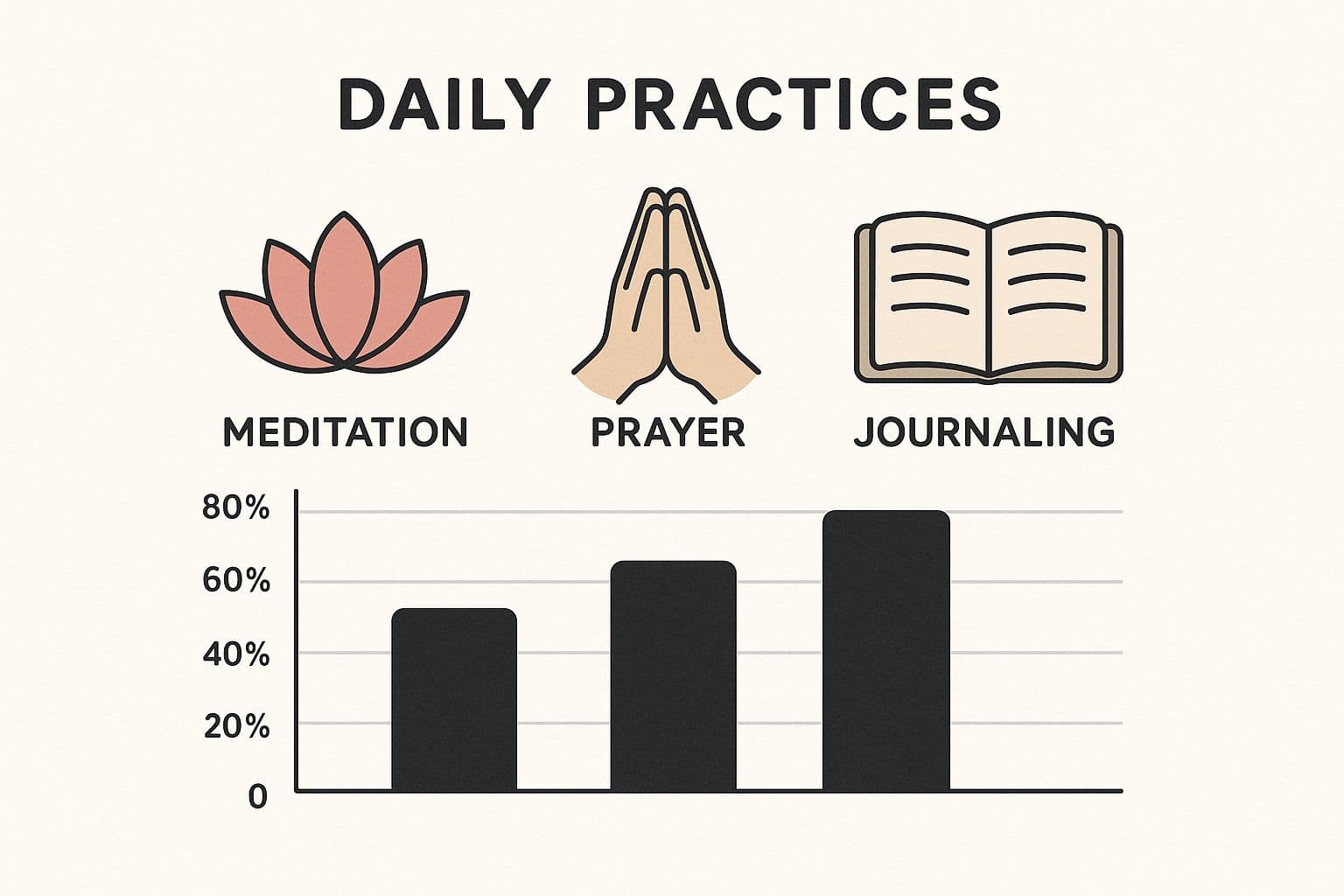Discover clear, practical steps to grow spiritually. Learn how to find your authentic starting point, build short daily practices that stick, connect with supportive people, and turn challenges into growth.
June 16, 2025 (6mo ago) — last updated October 28, 2025 (1mo ago)
Practical Spiritual Growth Guide
Practical, research-backed steps to grow spiritually: find your starting point, build micro-practices, connect with others, and transform challenges into growth.
← Back to blog
Practical Spiritual Growth Guide

Discover clear, practical steps to grow spiritually. This guide helps you find your authentic starting point, build daily practices that stick, connect with people who support your path, and turn life’s challenges into growth.
Finding Your Authentic Spiritual Starting Point
Spiritual growth begins with a simple question: what truly resonates with you? Seeing faith leaders at Davos discussing global issues is a reminder that spirituality matters beyond the personal realm1. But your journey starts inside — not by copying others, but by listening to your inner compass.
Many people try every trending practice and end up feeling unsettled. Instead, identify small, meaningful practices that fit your life. For example, short mindful breathing breaks may suit you better than an hour-long meditation routine. There’s no single right path; start with what feels authentic and build from there.
Build on your existing values and beliefs. What already feels meaningful? Use those threads as a springboard to deepen your practice. If you’re curious about exploring life purpose, see Find Your Life Purpose on the Life Purpose App for guided steps and prompts.
Crafting Daily Practices That Actually Stick
Spiritual growth is about consistency in your real life, not perfection. Micro-practices — brief, intentional actions during your day — compound into meaningful change over time. Research shows meditation programs improve stress and well-being, especially when practiced regularly2.

Designing Practices for a Busy Life
Transform existing moments into spiritual practice: practice mindful breaths while waiting in line, turn dishwashing into a gratitude practice, or do a two-minute check-in before bedtime. Small habits are sustainable and effective.
High-Impact Practices
Journaling and expressive writing are linked to improved emotional processing and well-being, even with short daily sessions3. Start with five to ten minutes of journaling or a short guided meditation from the Life Purpose App to build momentum.
Embracing Imperfection
Expect interruptions and imperfect sessions. Spiritual growth is progress over time, not flawless practice. Compassion and flexibility keep your practice alive when life gets messy.
| Practice | Time | Benefits | Start |
|---|---|---|---|
| Meditation | 5–20 min | Reduced stress, focus | Guided meditations (Life Purpose App) |
| Prayer | 5–15 min | Comfort, connection | Simple gratitude or requests |
| Journaling | 10–30 min | Self-reflection, clarity | Prompts tailored to your path |
Building Genuine Spiritual Connections
Community accelerates growth, but finding the right group takes discernment. Look for spaces that welcome questions, respect boundaries, and encourage autonomy rather than control. Pay attention to whether you feel uplifted or drained.
You don’t need a formal group to find connection; meaningful encounters can arise in everyday places. Practices like yoga can also foster community while supporting body-based spiritual growth.
Maintain authenticity in relationships: try suggestions, but don’t feel pressured to follow practices that don’t align with you. If you want to discover strengths to share with others, try the spiritual gifts test on the Life Purpose App.
As context for broader influence, faith traditions shape many communities worldwide. For example, recent reporting highlights trends in global Christianity growth and influence4.
Transforming Life’s Challenges Into Growth Fuel
Hard experiences often catalyze deeper spiritual insight. Rather than avoiding pain with forced positivity, engage with suffering as a teacher. Many wisdom traditions frame suffering as an opportunity to develop resilience and compassion.
When grief, loss, or setbacks arrive, lean into practices that help you process emotions. Real growth comes from integrating difficult feelings rather than bypassing them.
Finding Meaning in Struggle
Reframe setbacks as data about your values and priorities. Career losses, relationship shifts, and grief can reveal what truly matters and point toward a more aligned path.
Building Resilience
Resilience isn’t denying hardship; it’s learning to respond skillfully. Use spiritual tools to process emotions, seek support, and apply lessons from challenges to your daily life.
Making Ancient Wisdom Work in Modern Life
Ancient teachings offer practical tools, but they need adaptation. You don’t need hours each day; short, consistent practices rooted in tradition can be modernized for busy schedules.
Apply Stoic reframing to workplace stress, use mindfulness practices to manage social media use, or adapt Taoist patience to parenting. Respect traditions by acknowledging their origins while personalizing practices for your life.
| Modern Challenge | Ancient Practice | Adaptation | Outcome |
|---|---|---|---|
| Workplace stress | Stoicism | Focus on controllables | Reduced reactivity |
| Social media overload | Mindfulness | Short meditations, boundaries | More presence |
| Parenting tension | Taoism | Wu wei, flexibility | Greater harmony |
Recognizing Real Growth Without Losing Wonder
Real spiritual growth shows up as subtle internal shifts: increased emotional resilience, spontaneous compassion, and steadiness amid chaos. These are quieter than social-media milestones but more lasting.
Avoid spiritual bypassing — don’t use spirituality to dodge feelings. True growth integrates shadow work and awareness. Progress is non-linear: expect plateaus and spirals, not a straight climb.
Cultivate beginner’s mind even as you celebrate milestones. Curiosity keeps your practice fresh and prevents rigid expectations from causing burnout.
Designing Your Personal Spiritual Path Forward
Your path should reflect who you are and evolve as you change. Prioritize consistency over intensity: short daily practices beat sporadic extremes. Use accountability that supports you — a friend, a small group, or a course — not pressure.
When dry spells come, be patient. They often precede deeper growth. Adapt your practices over time and stay open to new tools that fit your current life.
Ready to explore guided options? Visit the Life Purpose App for meditations, prompts, and tools to support ongoing practice.
Common Questions (Q&A)
Q: How do I begin if I don’t know what spiritual practice suits me?
A: Start small and experiment. Try five minutes of breathing, a short guided meditation, or a five-minute journaling prompt. Notice what gives you more clarity or calm, and lean into that.
Q: I’m too busy for long routines. How can I maintain a practice?
A: Use micro-practices tied to daily moments: mindful breaths while commuting, gratitude during chores, or two minutes of reflection before bed. Consistency matters more than duration.
Q: How do I tell healthy spiritual guidance from manipulation?
A: Healthy guidance encourages autonomy, welcomes questions, and honors boundaries. If a group demands loyalty, isolates members, or shuts down doubt, it’s a red flag.
Discover Your Life Purpose Today!
Unlock your true potential and find your life’s purpose.
